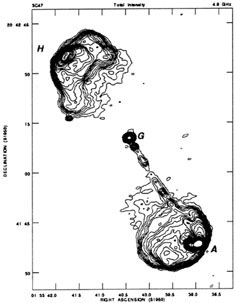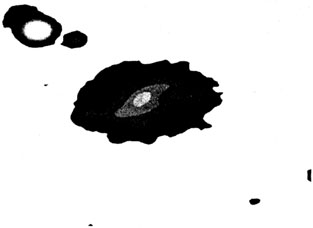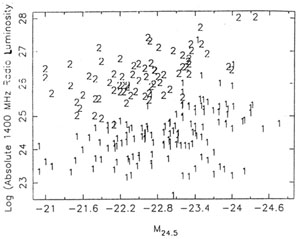
Adapted from Kembavi & Narlikar (1999) ``Quasars and Active Galactic Nuclei'', Cambridge University Press, Secion 9.3
It was first noticed by B.L. Fanaroff and J.M. Riley (1974) that the relative positions of regions of high and low surface brightness in the lobes of extragalactic radio sources are correlated with their radio luminosity. This conclusion was based on a set of 57 radio galaxies and quasars, from the complete 3CR catalogue, which were clearly resolved at 1.4 GHz or 5 GHz into two or more components. Fanaroff and Riley divided this sample into two classes using the ratio RFR of the distance between the regions of highest surface brightness on opposite sides of the central galaxy or quasar, to the total extent of the source up to the lowest brightness contour in the map. Sources with RFR < 0.5 were placed in Class I and sources with RFR > 0.5 in Class II. It was found that nearly all sources with luminosity
were of Class I while the brighter sources were nearly all of Class
II. The luminosity boundary between them is not very sharp, and there
is some overlap in the luminosities of sources classified as FR-I or
FR-II on the basis of their structures. For a spectral index of
At high frequencies the luminosity overlap between the two classes can
be as much as two orders of magnitude.
Various properties of sources in the two classes are different,
which is indicative of a direct link between luminosity and the way in
which energy is transported from the central region and converted to
radio emission in the outer parts. We will now provide a somewhat more
detailed description of the Fanaroff-Riley classes.
Fanaroff-Riley Class I (FR-I)
FR-I sources are associated with bright, large galaxies (D or cD)
that have a flatter light distribution than an average elliptical
galaxy and are often located in rich clusters with extreme X-ray
emitting gas (Owen and Laing 1989, Prestage and Peacock 1988). As the
galaxy moves through the cluster the gas can sweep back and distort
the radio structure through ram pressure, which explains why
narrow-angle-tail or wide-angle-tail sources, say, appear to be
derived from the FR-I class of objects.
Figure 9.3. VLA map of the FR-I galaxy
3C 449 at 1465 MHz, with angular
resolution 4.8 x 3.4 arcsec2. The peak flux is 22.2 mJy per
beam, with
contours drawn at 5 per cent intervals, beginning with the -5 per cent
contour. Reproduced from Perley, Willis and Scott (1979).
A typical FR-I galaxy is shown in
Figure 9.3 (Perley, Willis and
Scott 1979). This is the radio source 3C 449, which is optically
identified with a galaxy of type cDE4 at a redshift of 0.0181, so that
1 arcsec corresponds to 255 h100-1
pc. There are twin jets that are
straight for ~ 30 arcsec from the core, after which they deviate
towards the west and terminate into diffuse lobes. These jets and
outer lobes are mirror symmetric about an axis through the core. The
jets are generally smooth in appearance, but higher resolution
observations show knots on a smooth ridge of emission, the southern
jet being more knotty than the northern one. Within ~ 10 arcsec of the
nucleus, the surface brightness of the jets is much reduced. The jets
widen at a non-uniform rate close to the core, with the greatest
expansion occurring where the jets are faintest. Beyond ~ 10 arcsec
from the nucleus the opening angle is constant at ~ 7 deg. The
emission from the jets is highly polarized, the average polarization
over the jets being ~ 30 per cent, and the projected magnetic field is
perpendicular to the jet axis.
Fanaroff-Riley Class II (FR-II)
FR-II sources are generally associated with galaxies that appear
normal, except that they have nuclear and extended emission line
regions. The galaxies are giant ellipticals, but not first-ranked
cluster galaxies. Their average absolute magnitude < MR >
= -19.9 (H0 =
100 km sec-1 Mpc-1) is close to the characteristic
value M* of the
Schechter galaxy luminosity function (see e.g. MB81, p. 352) at which
the density of galaxies shows an exponential turnover. The environment
of FR-II sources does not show enhanced galaxy clustering over the
environment of randomly chosen elliptical galaxies (Owen and Laing
1989, Prestage and Peacock 1988). Owing to the large differences in
the nature of the host galaxies and the environments of the FR-I and
FR-II sources, it is possible that they are intrinsically different
types of source not related to each other through an evolutionary
sequence (but see the remark towards the end of this section).
Figure 9.4. A VLA map of the FR-II quasar
3C 47 (Bridle et al. 1994)
made at 4.9 GHz with 1.45 x 1.13 arcsec2 resolution. G is the
core, A
the jetted hotspot. H does not meet the hotspot criteria of Bridle et
al. The figure was kindly provided by Alan Bridle.
Host galaxies
Figure 9.5. CCD image in the B filter of
the MRC radio
galaxy 1222-252
taken with the 1 m telescope of the Carnegie Observatory at Las
Campanas. The image was kindly provided by A. Mahabal.
Bivariate classification
Physical distinction
Figure 9.6. Distribution of FR-I and FR-II
radio galaxies as a function
of their 1400 MHz radio luminosity and absolute B
magnitude. Reproduced from Owen and Ledlow (1994) in BDQ94.
A model of the first kind has been proposed by De Young (1993), who
has made an earlier version of
Figure 9.6 as the basis. He notes that
for a given radio luminosity in the figure, there is an optical
luminosity limit that separates the two types of source. Sources
fainter than this limit are FR-II, while those brighter than it are
FR-I. Since the transition occurs at a fixed radio luminosity, De
Young concludes that there is no major change in the engine that
produces the radio emission, and the difference between the two types
must be an environmental effect.
(1)
De Young suggests that jets in FR-I galaxies are decelerated a short
distance outside the production region. Thus, in the short distance
before significant deceleration begins, the jets interact very little
with the matter, and have low luminosity, which explains the gap often
found between the nucleus and the base of jets in FR-I sources (see
Section 9.4). After the deceleration the jets must proceed relatively
unimpeded over large distances, as otherwise the outflow would cease
completely. The deceleration can be produced by transfer of momentum
from the jet to a dense ambient gas if the Reynolds number is very
large, which is likely to be the case for reasonable jet dimensions
and speeds. The dense ambient medium can be produced by the inflow of
gas into the central region, owing to stellar mass loss, flows set up
by interactions, cooling flows etc.
It is expected that active star formation will take place owing to
the enhanced density of the central region, and also the action of the
jet on it. This should make the central regions of FR-I galaxies bluer
than those in FR-II galaxies. Testing such a prediction requires good
signal-to-noise images in two or more colours of a number of radio
galaxies, and a detailed study along these lines is yet to be made.
The second possibility, that the differences between the FR-I and
FR-II galaxies are due to qualitative differences in the properties of
the central engine, has been considered by Baum, Zirbel and O'Dea
(1995). They base their conjecture on a detailed study of the
correlations between radio luminosity, emission line luminosity and
host galaxy magnitude of a large sample of FR-I and FR-II galaxies;
this spans 10 orders of magnitude in luminosity and contains a number
of galaxies of the two types that overlap in luminosity.
The principal differences found in the two types by Baum et al. are as
follows.
The observed distribution of the [O III] /
H
Baum et al. furthermore suggest that FR-I sources are produced when
the accretion rate onto the central black hole is low, and the black
hole has relatively less angular momentum; the FR-II sources arise
when the accretion rate is high and the hole spins more rapidly. The
different degrees of black hole spin make a difference to the nature
of the jets produced, leading to subsonic jets when the spin is low
and supersonic jets when it is high. As we have mentioned above, these
different jet properties can lead to different levels of interaction
with the ambient medium, creating different radio morphologies. Baum
et al. also suggest that a high accretion rate could decline with
time, causing an FR-II galaxy to evolve into an FR-I type. The
correlations that have been used in arriving at this picture, the
conclusions drawn from them and the theoretical conjectures all need
thorough study before the scenario can be accepted as plausible. We
have seen above that the environments of the two types of radio galaxy
are likely to be different. This seems to argue against the two types
having an evolutionary connection. But it is possible that at least
some of the FR-I galaxies began as FR-II galaxies in the dense
environments of rich clusters and relatively quickly evolved to the
FR-I state (Hill and Lilly 1991).
 2 x
1025 h100-2 W Hz-1
str-1,
2 x
1025 h100-2 W Hz-1
str-1,

 1
the dividing luminosity at 5 GHz is
1
the dividing luminosity at 5 GHz is
 7 x
1023 h100-2 W Hz-1
str-1.
7 x
1023 h100-2 W Hz-1
str-1.
 8 deg that varies along its
length. Along the jet the component of the magnetic field in the
plane of the sky is at first parallel to the jet axis, but soon
becomes aligned predominantly perpendicular to the axis (see Figure
9.10).
8 deg that varies along its
length. Along the jet the component of the magnetic field in the
plane of the sky is at first parallel to the jet axis, but soon
becomes aligned predominantly perpendicular to the axis (see Figure
9.10).



 Lop2. When the two-dimensional distribution
of points is projected
onto the radio luminosity axis, the two types remain separated but
with some mixing at the boundary. The dependence of the dividing radio
luminosity on the optical luminosity is a reflection of the form of
the bivariate luminosity function (see Section 7.11).
Lop2. When the two-dimensional distribution
of points is projected
onto the radio luminosity axis, the two types remain separated but
with some mixing at the boundary. The dependence of the dividing radio
luminosity on the optical luminosity is a reflection of the form of
the bivariate luminosity function (see Section 7.11).

 line ratio in FR-I
galaxies is similar to the distribution for radio-quiet ellipticals
and cooling flow galaxies. Baum et al. suggest that the emission lines
here are of the low ionization type, which are different from the high
ionization lines produced owing to ionizing radiation from the nucleus
in Seyfert and other active galaxies. Since the line luminosity is
also correlated with the host galaxy optical luminosity, Baum et
al. conclude that the line emission in FR-I galaxies could be produced
by processes in the host galaxy. In contrast to this, available
evidence suggests that in FR-II galaxies the lines are produced as a
result of an ionizing continuum from the nucleus. This points to a
possible important difference between the central engines of FR-I and
FR-II galaxies: the engines in the former produce far less ionizing
radiation and funnel a higher fraction of their total energy output
into the kinetic energy of the jets than FR-II galaxies.
line ratio in FR-I
galaxies is similar to the distribution for radio-quiet ellipticals
and cooling flow galaxies. Baum et al. suggest that the emission lines
here are of the low ionization type, which are different from the high
ionization lines produced owing to ionizing radiation from the nucleus
in Seyfert and other active galaxies. Since the line luminosity is
also correlated with the host galaxy optical luminosity, Baum et
al. conclude that the line emission in FR-I galaxies could be produced
by processes in the host galaxy. In contrast to this, available
evidence suggests that in FR-II galaxies the lines are produced as a
result of an ionizing continuum from the nucleus. This points to a
possible important difference between the central engines of FR-I and
FR-II galaxies: the engines in the former produce far less ionizing
radiation and funnel a higher fraction of their total energy output
into the kinetic energy of the jets than FR-II galaxies.
1 It may be more appropriate here to
consider the core radio
luminosity, but this is not known in all cases, and where known it is
at least approximately proportional to the extended radio luminosity.
Back.